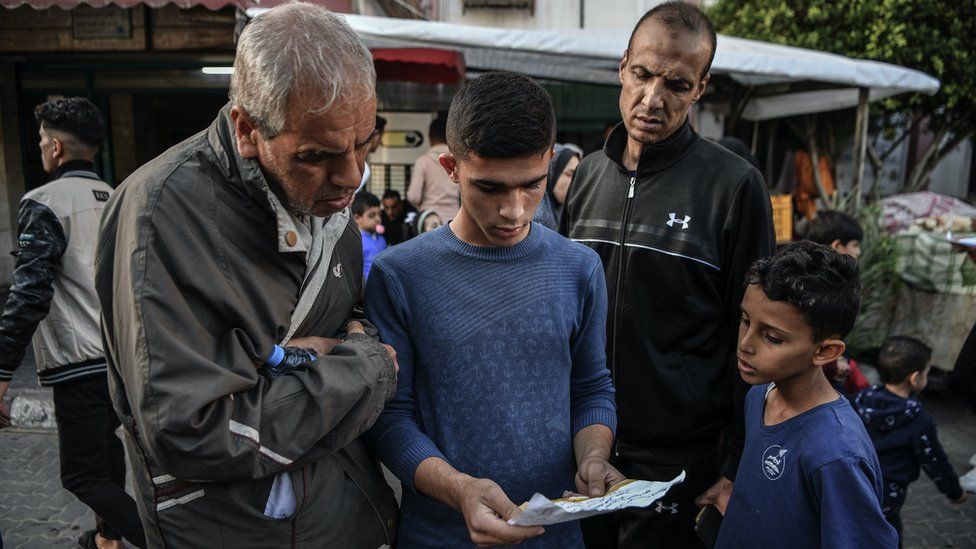ARTICLE AD BOX
 Image source, Getty Images/Anadolu
Image source, Getty Images/Anadolu
Two men and two boys on a street in Gaza look at a leaflet containing an IDF evacuation warning
By Stephanie Hegarty & Ahmed Nour
BBC World Service & BBC Arabic
Evacuation warnings issued by Israel to people in Gaza ahead of attacks have contained a host of significant errors, BBC analysis has revealed.
Warnings contained contradictory information and sometimes misnamed districts. This made them confusing.
Experts say such mistakes could violate Israel's obligations under international law.
The Israel Defense Forces (IDF) has rejected any assertion the warnings were confusing or contradictory.
In a statement, it said the alerts analysed by the BBC were only one element of its "extensive efforts to encourage the evacuation [of] civilians out of harm's way".
International humanitarian law requires attacking forces to give effective advance warning of attacks which may affect the civilian population, unless circumstances do not permit.
Israel says its warning system is designed to help civilians flee danger as it continues its war against Hamas. The system divides a map of Gaza into hundreds of numbered blocks.
Israel has produced an interactive online map of the blocks that geo-locates users, showing their live location and which block number they are in.
This IDF post from late January shows a social media post on X with a link through via QR code to the master block map.
But people we spoke to have described struggling to get online to access the system, as well as finding the block system difficult to understand, notwithstanding the errors.
The BBC analysed the IDF's Arabic language social media channels on Facebook, X and Telegram, where we found hundreds of posts containing warnings. The same warnings were often posted repeatedly.
We also searched for leafleted warnings which had been photographed and shared online. The IDF says it has dropped 16 million such leaflets over Gaza.
We have focused our analysis on warnings issued since 1 December, which is when the IDF launched its block system as a way of providing more precise instructions than previously, after coming under international pressure.
We grouped all of the IDF's posts and leaflets that we found after this date into 26 separate warnings. The vast majority made reference to the master block system.
The IDF told the BBC it also warned of impending attacks through pre-recorded phone messages and live phone calls. Due to damage to Gaza's phone network we have not been able to compile data on these phone calls.
And our analysis of leaflets was limited to those we could find photographed and shared online.
The 26 separate warnings we found contained specific information from the IDF that people could use to escape areas of danger. But 17 of them also contained errors and inconsistencies.
- Twelve warnings in which blocks or neighbourhoods were listed in the text of the post but not highlighted on the accompanying map
- Nine in which areas were highlighted on the map but not listed in the accompanying text
- Ten warnings in which the evacuation zone shaded on the map cut blocks in two, potentially causing confusion
- Seven in which arrows on the map that were supposed to point to areas of "safety" actually pointed to areas also under evacuation
In addition, one warning listed neighbourhoods as being in one district when they were actually in another. Another mixed up the block numbers of two neighbourhoods. And in a third, some blocks listed in the text were on the opposite side of Gaza to those highlighted on the accompanying map.
When we put these errors to the IDF, it did not respond to the issues we raised with the maps specifically but said the text of posts had been sufficiently clear. It also said that when arrows were used to direct people to safety, "it is obvious that the arrows point to a general direction" and reiterated that the key information had been provided in the text.
These inaccuracies and errors may violate Israel's obligation under international law to provide "effective advanced warnings", says Janina Dill, co-director of the Oxford Institute of Ethics, Law and Armed Conflict.
If the majority of warnings contain errors or are unclear to the point that civilians can't understand them then, she says, "these warnings do not fulfil the proper function they have under international humanitarian law".
This, adds Kubo Macak professor of international law at the University of Exeter, undermines their function to give "civilians the chance to protect themselves".
'Big argument'
In December, Saleh, a tech entrepreneur from Gaza City, was sheltering with his children and his in-laws in Nuseirat in central Gaza - where, he says, there was no electricity or phone signal and long periods of internet outage.
He saw people killed and others fleeing from a nearby school as it was being shelled, but says he had not received any IDF evacuation details.
Eventually, he found someone with a Sim card that allowed him to access data networks in Egypt and Israel and came across an evacuation warning on an Israeli government Facebook page.
"There was an evacuation order for several residential blocks - [but] we didn't know which block we lived in. This led to a big argument," Salah says.
Salah could only access the internet intermittently, but he messaged his wife Amani, who has been in the UK since just before the war. She was able to go online and access the IDF's master block map and pinpoint where her husband was. But then, looking back at the specific evacuation warning on Facebook, the couple realised the numbered block where Salah was staying was shown cut in two - adding to the family's confusion.
Eventually, Salah decided to leave with the children. But some of his family stayed put - until fighting escalated further.
When the BBC analysed the Facebook evacuation warning Salah had been trying to decipher, we found further points of confusion.
In text, the post urged people to leave blocks 2220, 2221, 2222, 2223, 2224 and 2225 - all blocks that appear in the IDF's online master map.
But in the accompanying map, the six numbered blocks had been lumped into one, and mislabelled as block 2220.
Despite these inconsistencies, Israel presented its block warning system at the International Court of Justice in January as part of its defence against allegations by South Africa that it is committing genocide.
Israel's lawyers argued that it was doing its utmost to protect civilians and had "developed a detailed map so that specific areas can be temporarily evacuated, instead of evacuating entire areas".
They presented one social media warning in court as evidence - but the BBC has found two errors in it.
Block 55 and 99 were listed in the text of the post from 13 December but they were not shaded on the map.
The IDF told the BBC that when a block number is explicitly mentioned in text, the warning is sufficiently clear.
Israel's lawyers also claimed that the IDF, via its Arabic Twitter account, was providing information on the location of shelters close to areas being evacuated. But in all of the posts and leaflets we analysed we did not see any warning providing names or exact locations of shelters.
BBC analysis has also found the IDF's block system overall was used inconsistently. Nine of the 26 warnings listed a mix of block numbers and neighbourhood names. Another nine didn't mention block numbers at all. Despite linking through to the online master map, they instead listed neighbourhoods by name - which often sprawled over many numbered blocks.
The BBC could not find a way to determine the exact blocks of these neighbourhoods.
The Abdu family, which includes 32 people, also fled Gaza City to central Gaza early in the war. Then, in December, they received a warning leaflet dropped from a plane.
Messages on the family Whatsapp group, which the BBC has seen, chart their confusion as they argued for two days over what the leaflet meant.
It contained a list of neighbourhoods to evacuate, but the family couldn't locate most of these places.
The warning asked people to leave "Al-Bureij Camp and the neighbourhoods of Badr, the North Coast, al-Nuzha, al-Zahra, al-Buraq, al-Rawda, and al-Safa in the areas south of Wadi Gaza."
We located an al-Zahra and a Badr close by, but they are north of the Wadi Gaza riverbed. We could not find the neighbourhoods of al-Rawda or al-Nuzha in the "areas south of Wadi Gaza".
The Abdu family struggled to decide what to do. Should they stay and risk getting caught up in a fierce ground battle - or leave, and abandon the only shelter they might find?
Some followed the warning to go to "shelters in Deir al-Balah". But when they arrived they felt unsafe and decided to return. If they were going to die they would die together, they told us.
Satellite data on destruction in Gaza - analysed by Jamon Van Den Hoek at Oregon State University and Corey Scher of City University New York Graduate Center - shows that the area of Deir al-Balah that the family fled to came under more intense attack during this period than the area that they had left.
The IDF told us it had cross-checked "data regarding civilian presence and movement that followed these warnings" and that many people did receive and follow them.
It said that warnings had "saved countless civilian lives in the Gaza Strip".

 9 months ago
53
9 months ago
53








 English (US) ·
English (US) ·